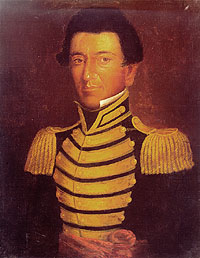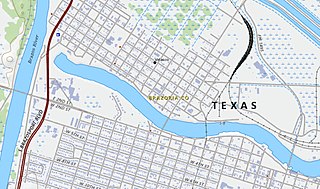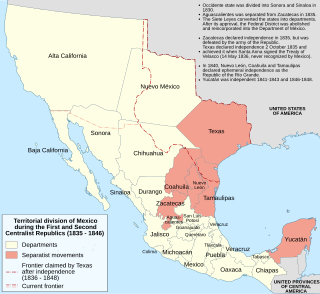Related Research Articles

Washington-on-the-Brazos is an unincorporated community along the Brazos River in Washington County, Texas, United States. The town is best known for being the site of the Convention of 1836 and the signing of the Texas Declaration of Independence.

Erastus "Deaf" Smith, who earned his nickname due to hearing loss in childhood, was an American frontiersman noted for his part in the Texas Revolution and the Army of the Republic of Texas. He fought in the Grass Fight and the Battle of San Jacinto. After the war, Deaf Smith led a company of Texas Rangers.

Juan Nepomuceno Seguín was a Spanish-Tejano political and military figure of the Texas Revolution who helped to establish the independence of Texas. Numerous places and institutions are named in his honor, including the county seat of Seguin in Guadalupe County, the Juan N. Seguin Memorial Interchange in Houston, Juan Seguin Monument in Seguin, World War II Liberty Ship SS Juan N. Seguin, Seguin High School in Arlington.
William Joel Bryan was a Texas soldier and planter.

Velasco was a town in Texas, United States, that was later merged with the city of Freeport by an election conducted by eligible voters of both municipalities on February 9, 1957. The consolidation effort passed by a margin of 17 votes. Founded in 1831, Velasco is situated on the east side of the Brazos River in southeast Texas. It is 16 miles (26 km) south of Angleton, and 4 miles (6.4 km) from the Gulf of Mexico.
Joaquín Ramírez y Sesma was a 19th-century general for the Republic of Mexico.

The Runaway Scrape events took place mainly between September 1835 and April 1836 and were the evacuations by Texas residents fleeing the Mexican Army of Operations during the Texas Revolution, from the Battle of the Alamo through the decisive Battle of San Jacinto. The ad interim government of the new Republic of Texas and much of the civilian population fled eastward ahead of the Mexican forces. The conflict arose after Antonio López de Santa Anna abrogated the 1824 Constitution of Mexico and established martial law in Coahuila y Tejas. The Texians resisted and declared their independence. It was Sam Houston's responsibility, as the appointed commander-in-chief of the Provisional Army of Texas, to recruit and train a military force to defend the population against troops led by Santa Anna.
James Clinton Neill was a 19th-century American soldier and politician, most noted for his role in the Texas Revolution and the early defense of the Alamo. He was born in North Carolina.

Richard Andrews was a Texian merchant and soldier who was the first killed in action casualty of the Texas Revolution during the Battle of Concepción on October 28, 1835. He is a folk hero for his purported final words "I am a dead man, but don't let the other boys know it. Tell them to conquer or die."

Vicente Filísola was an Italian-born Spanish and Mexican military and political figure during the 19th century. He is most well known for his role in leading the short-lived Mexican annexation of Central America between 1822 and 1823.
The Texan schooner Independence was one of the four schooners of the First Texas Navy (1836–1838). At the direction of Texas Governor Henry Smith, in 1836 Charles Hawkins took command of United States revenue cutter Ingham acquired by the Texas Navy and renamed Independence.
Elizabeth Powell was a Texas colonist who received a land grant for a league of land from the Mexican government in present day Powell Point, Fort Bend County, Texas, on the waters of the San Bernard River and Turkey Creek. Powell operated a boarding house and bar that was a popular stop considering there were not many establishments in early Texas.

Egypt is an unincorporated community in northern Wharton County in the U.S. state of Texas. According to the Handbook of Texas, the community had a population of 26 in 2000. It is located within the Greater Houston metropolitan area.
Sion Record Bostick was a soldier for the Texas Army during the Texas Revolution, and later fought for the Confederate States Army during the American Civil War. Bostick is most famous as one of the Texas Army scouts who captured Antonio López de Santa Anna during the Texas Revolution.

Texas Gulf Coast is an intertidal zone which borders the coastal region of South Texas, Southeast Texas, and the Texas Coastal Bend. The Texas coastal geography boundaries the Gulf of Mexico encompassing a geographical distance relative bearing at 367 miles (591 km) of coastline according to CRS and 3,359 miles (5,406 km) of shoreline according to NOAA.

John Austin Wharton was distinguished Texian statesman, lawyer, and soldier. He served as Adjutant General at the Battle of San Jacinto. In a eulogy at his grave, Republic of Texas President David G. Burnet said of him, "The keenest blade on the field of San Jacinto is broken." He died a bachelor on December 17, 1838, while serving as a member of the Texas Congress. His nephew, John A. Wharton, who would go on to be a Confederate Army general, was named for him.
William "Bill" Smeathers, also known as Smithers or Smothers, was a pioneer settler of Kentucky and later Texas.
Fort Velasco was a small circular palisade fort built by a garrison of Mexican soldiers at Velasco, Texas at the present-day location of Surfside Beach on the northeast bank at the mouth of the Brazos River and Texas Gulf Coast. The name also applies to at least three other forts built at almost the same location, one during the Texas Revolution, and two during the Civil War.
Robert M. Coleman was a Texan and later American politician, soldier, and aide-de-camp to Sam Houston. Coleman was a signer of the Texas Declaration of Independence, a Colonel, and a transitional founder of the Republic of Texas into the United States as a constituent state. His opposition to the strategies of Sam Houston regarding defense of the Alamo, and troop placements on up through the Battle of San Jacinto caused a rift with Houston and a posturing treatise, lending suspicion to the untimely death of Coleman by drowning.
References
- ↑ "Statement of Robert Moore, July 24, 1836". Texas state library and archives commission.
